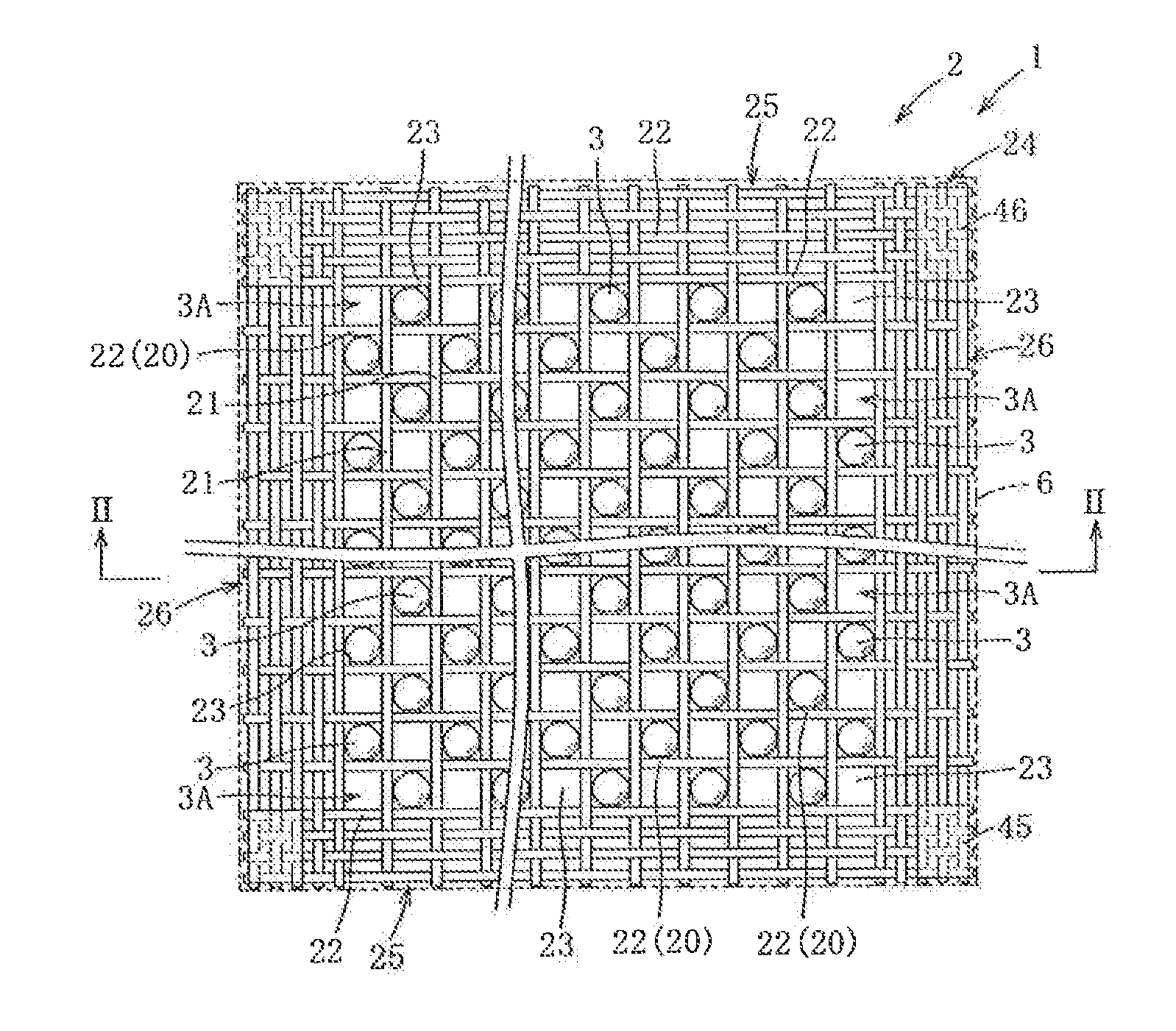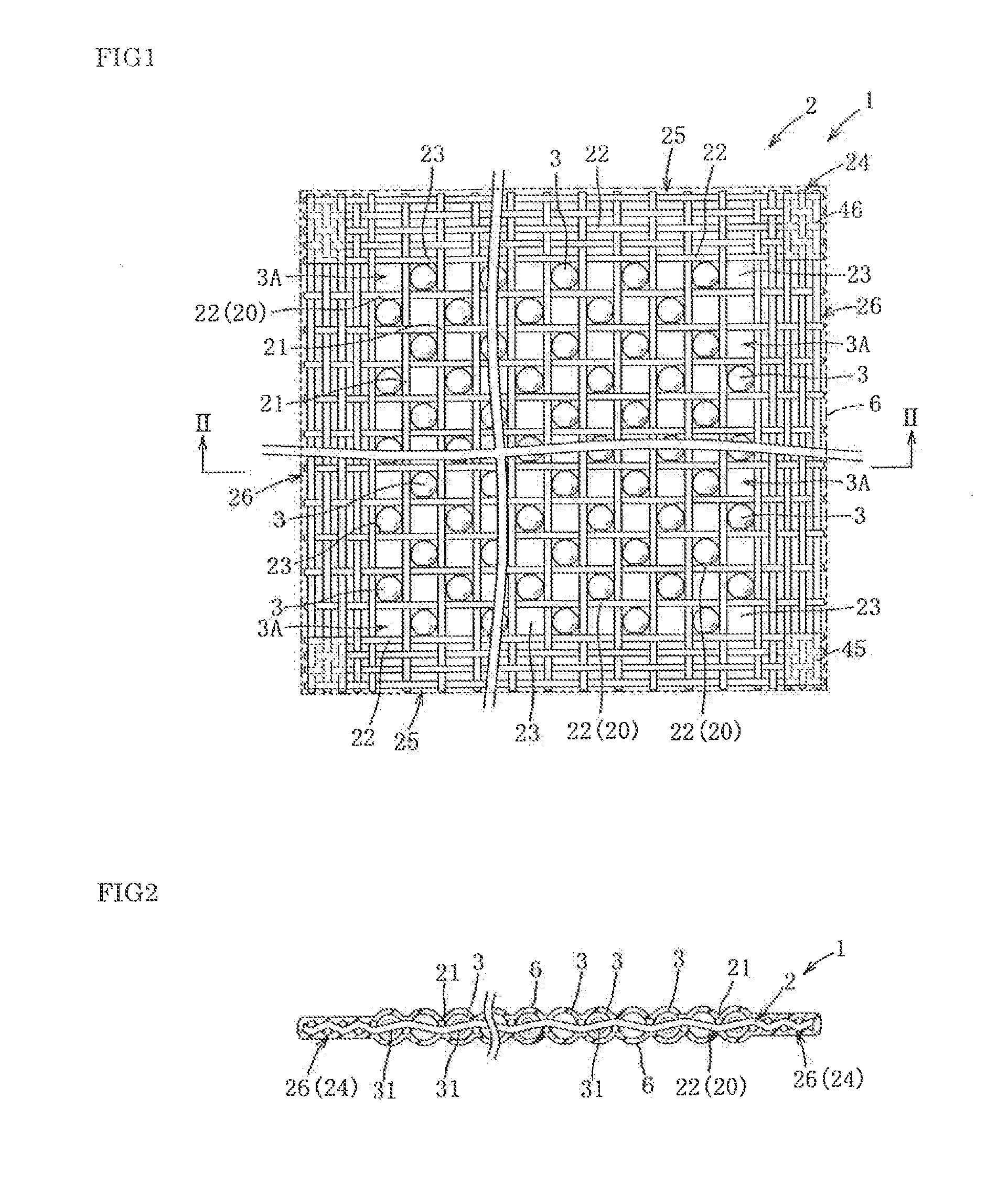Woven mesh substrate with semiconductor elements, and method and device for manufacturing the same
a technology of semiconductor elements and woven mesh, which is applied in the direction of weaving, looms, yarns, etc., can solve the problems of high defect ratio of solar battery modules, inability to test the functioning and danger of spherical semiconductor elements being torn away, so as to reduce the number of components and reduce the manufacturing cost. , the effect of reducing the number of components
- Summary
- Abstract
- Description
- Claims
- Application Information
AI Technical Summary
Benefits of technology
Problems solved by technology
Method used
Image
Examples
embodiment 1
[0080]First, the woven mesh substrate with semiconductor elements 1 of the present invention will be explained.
[0081]As shown in FIGS. 1 through 3, the woven mesh substrate with semiconductor elements 1 (hereinafter termed the “woven mesh substrate with elements 1”) comprises: a woven mesh substrate 2 that is formed as a net having meshes 23 in matrix form arranged in a plurality of rows and a plurality of columns, and woven from a plurality of vertical strands 21 that are insulating and a plurality of horizontal strands 22 that are conductive; a plurality of spherical solar cells 3 (which correspond to spherical semiconductor elements) that are installed to the plurality of meshes 23 of the woven mesh substrate 2; and a plurality of first and second conducting junction materials 4, 5 for connecting these spherical solar cells 3 to the horizontal strands 22 (i.e. to conductive connection members 20). Protective insulating layers 6 are formed on both the sides of the woven mesh subst...
embodiment 2
[0164]While, in this embodiment, there are described a woven mesh substrate with semiconductor elements 1A in which the woven mesh substrate with semiconductor elements 1 of the above Embodiment #1 is partially altered, and a manufacturing device 50A for manufacturing this woven mesh substrate with semiconductor elements 1A in which the manufacturing device 50 described above is partially altered and a manufacturing method for the woven mesh substrate with semiconductor elements 1A, to constitutional elements that are similar to elements of the first embodiment the same reference numerals will be appended, and explanation thereof will be omitted, with only those elements that are different being explained.
[0165]First, the woven mesh substrate with semiconductor elements 1A will be explained. As shown in FIGS. 9 and 10, the woven mesh substrate with attached semiconductor elements 1A (hereinafter “woven mesh substrate with elements 1A”) is a device that produces a similar woven mesh ...
embodiment 3
[0174]While, in this embodiment, a manufacturing device 50B is described in which the manufacturing devices 50, 50A described above for manufacturing the woven mesh substrates with elements 1, 1A are partially altered, to constitutional elements that are similar to elements of the first and second embodiments the same reference numerals will be appended, and explanation thereof will be omitted, with only those elements that are different being explained. It should be understood that while, with the manufacturing devices 50, 50A of the first and second embodiments described above, the woven mesh substrates with elements 1, 1A were woven while being pulled out in the horizontal direction, with the manufacturing device 50B of this embodiment, the woven mesh substrate with elements 1, 1A is woven while being pulled out downwards.
[0175]First, the manufacturing device 50B will be explained.
[0176]As shown in FIGS. 13 and 14, the manufacturing device 50B is substantially the manufacturing d...
PUM
| Property | Measurement | Unit |
|---|---|---|
| length | aaaaa | aaaaa |
| diameter | aaaaa | aaaaa |
| diameter | aaaaa | aaaaa |
Abstract
Description
Claims
Application Information
 Login to View More
Login to View More - R&D
- Intellectual Property
- Life Sciences
- Materials
- Tech Scout
- Unparalleled Data Quality
- Higher Quality Content
- 60% Fewer Hallucinations
Browse by: Latest US Patents, China's latest patents, Technical Efficacy Thesaurus, Application Domain, Technology Topic, Popular Technical Reports.
© 2025 PatSnap. All rights reserved.Legal|Privacy policy|Modern Slavery Act Transparency Statement|Sitemap|About US| Contact US: help@patsnap.com



